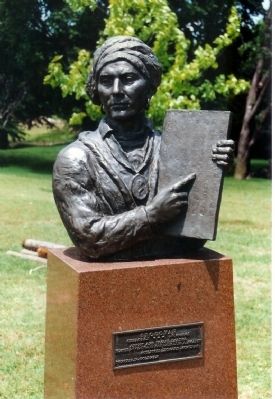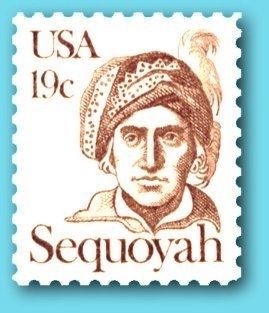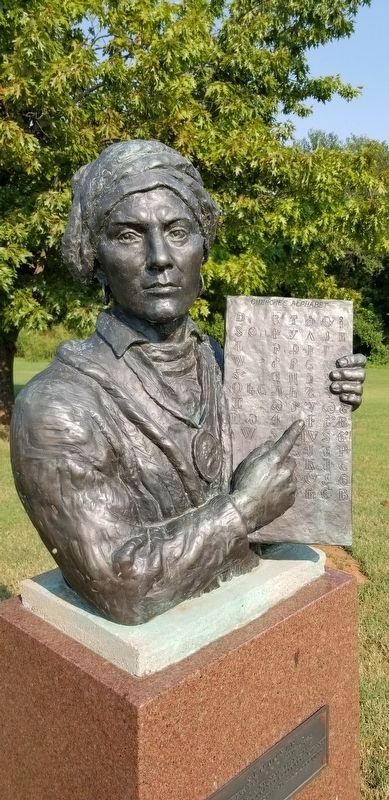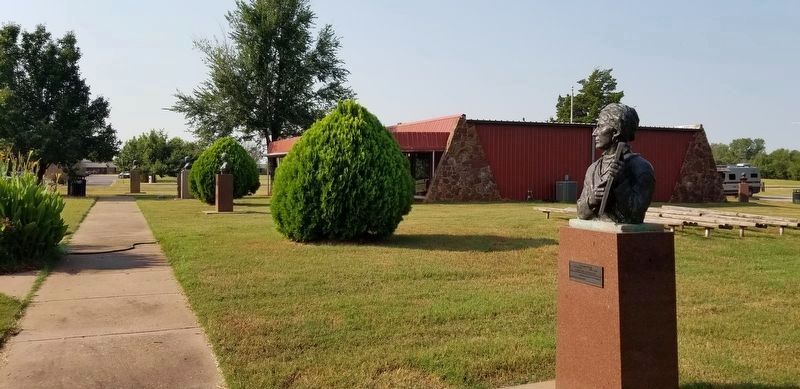Anadarko in Caddo County, Oklahoma — The American South (West South Central)
Sequoyah
Artist and tribal leader
Famous inventor of the Cherokee Alphabet
Sculptor Leonard McMurry
Erected by National Hall Of Fame For Famous American Indians.
Topics and series. This historical marker is listed in these topic lists: Arts, Letters, Music • Communications • Native Americans. In addition, it is included in the Trail of Tears series list.
Location. 35° 4.376′ N, 98° 13.716′ W. Marker is in Anadarko, Oklahoma, in Caddo County. Touch for map. Marker is at or near this postal address: 851 East Central Boulevard, Anadarko OK 73005, United States of America. Touch for directions.
Other nearby markers. At least 8 other markers are within walking distance of this marker. Chief Joseph (a few steps from this marker); Black Beaver (Se-Ket-Tu-Ma-Qua) (a few steps from this marker); Pocahontas (a few steps from this marker); Jim Thorp (a few steps from this marker); Hiawatha (within shouting distance of this marker); Allen Wright (Kuliahote) (within shouting distance of this marker); Geronimo (within shouting distance of this marker); Osceola (Asi Yahola) (within shouting distance of this marker). Touch for a list and map of all markers in Anadarko.
Regarding Sequoyah. Sequoyah, who also had the white name of George Guess (though he could speak no English), is believed to have been born around 1773 in the portion of the Cherokee Nation that fell in Georgia. He devised a set of written characters and symbols that could be used to represent spoken syllables in the Cherokee language. His syllabary made possible a written constitution and newspaper -- the Cherokee Phoenix -- for the Cherokees before their forced removal to Oklahoma in 1838 in what was known as the Trail of Tears. Realizing that removal was inevitable, Sequoyah joined a group of Cherokees that migrated to Arkansas in 1822. Sequoyah died near San Fernando, Mexico in 1843.(GeorgiaInfo)
Also see . . .
1. Sequoyah at Wikipedia. (Submitted on March 2, 2010, by Mike Stroud of Bluffton, South Carolina.)
2. The Cherokee Language And How To Use It. (Submitted on December 3, 2019, by Devry Becker Jones of Washington, District of Columbia.)
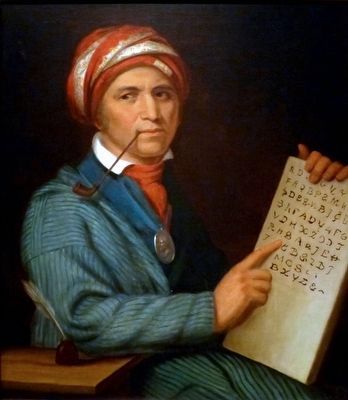
Photographed By Allen C. Browne, February 16, 2015
4. Sequoyah
This c. 1830 portrait of Sequoyah by Henry Inman after Charles Bird King hangs in the National Portrait Gallery in Washington, DC.
“Born Cherokee town of Tuskegee, eastern Tennessee, Sequoyah, the son of a Cherokee chief's daughter and a fur trader from Virginia, was a warrior and hunter and, some say, a silversmith. For twelve years he worked to devise a method of writing for the Cherokee language. His syllabary of eighty-five symbols representing vowel and consonant sounds was approved by the Cherokee chiefs in 1821. The simple utilitarian system made possible a rapid spread of literacy throughout the Cherokee nation. Medicine men set down ceremonies for healing, divination, war, and traditional ball games; missionaries translated hymns and the New Testament into the native language; and in 1828 the Cherokee Phoenix, a weekly bilingual newspaper, began publication at New Echota, Georgia.
The original portrait of Sequoyah, commissioned by Thomas McKenney and painted by Charles Bird King, was destroyed by the fire that swept through the Smithsonian Castle building in January 1865.” — National Portrait Gallery
“Born Cherokee town of Tuskegee, eastern Tennessee, Sequoyah, the son of a Cherokee chief's daughter and a fur trader from Virginia, was a warrior and hunter and, some say, a silversmith. For twelve years he worked to devise a method of writing for the Cherokee language. His syllabary of eighty-five symbols representing vowel and consonant sounds was approved by the Cherokee chiefs in 1821. The simple utilitarian system made possible a rapid spread of literacy throughout the Cherokee nation. Medicine men set down ceremonies for healing, divination, war, and traditional ball games; missionaries translated hymns and the New Testament into the native language; and in 1828 the Cherokee Phoenix, a weekly bilingual newspaper, began publication at New Echota, Georgia.
The original portrait of Sequoyah, commissioned by Thomas McKenney and painted by Charles Bird King, was destroyed by the fire that swept through the Smithsonian Castle building in January 1865.” — National Portrait Gallery
Credits. This page was last revised on September 17, 2021. It was originally submitted on March 2, 2010, by Mike Stroud of Bluffton, South Carolina. This page has been viewed 1,401 times since then and 18 times this year. Photos: 1, 2. submitted on March 2, 2010, by Mike Stroud of Bluffton, South Carolina. 3. submitted on September 17, 2021, by James Hulse of Medina, Texas. 4. submitted on November 14, 2015, by Allen C. Browne of Silver Spring, Maryland. 5. submitted on September 17, 2021, by James Hulse of Medina, Texas. • Bill Pfingsten was the editor who published this page.
